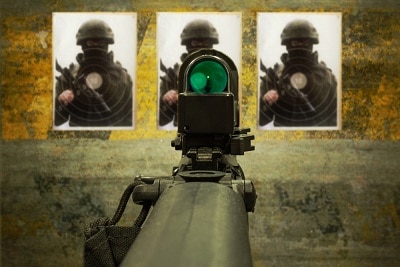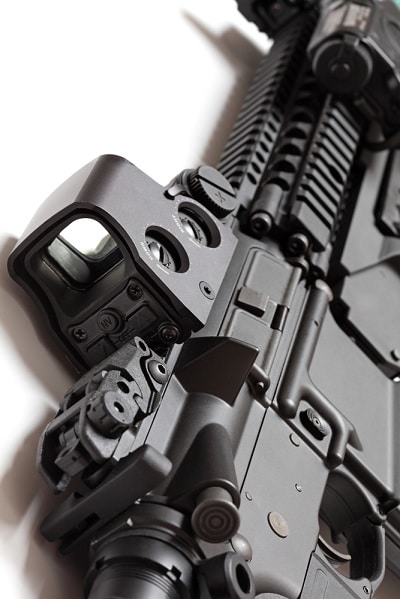Red dot sights are extremely common on many modern rifles.
While they are extremely simple sights, most people do not understand exactly how they work.

Red Dot Sights in use
Curious about the basics of red dot sights? Look no further. In this article, we will go over the types of red dot sights, how they work, pros and cons of red dot sights, and potential uses.
Red dot sight is NOT exactly a specific type of sight; it is more of a general term.
The term “red dot sight” is used to describe any number of electronic weapon optics that utilize a red dot as an aiming point.
Green dots are also extremely common in weapons optics that would usually be referred to as a “red dot sight.”
Types of Red Dot Sights and How They Work
The different types of red dot sights have been written about on this website before, but I will give a very brief refresher of each, if you want to find more, click here:
- The first type is a prism sight. Prism sights are very small and utilize a prism to focus the image you see down the scope, rather than the traditional series of lenses. They are often called “red dot sights” because of the illuminated reticle they commonly have. Generally speaking, they offer a small magnification.
- Reflex sights are the most common type of red dot sights. Exposed reflex sights have an aiming point that is projected from the rear of the sight onto one single aiming window. They are extremely small, as they only have one small window. When you think of a “red dot sight,” odds are you are thinking about an exposed reflex sight. Internal reflex sights have two lenses, and the rear one projects the aiming point onto the forward lens. They are a tube shape.
- Holographic sights are similar in appearance to exposed reflex sights. They differ in that they essentially use a picture of a reticle sandwiched between glass layers. EOTech owns the patent on holographic sights.
I already have post compare red dot vs scope, You should read it if you are confusing about this.
What Are Pros and Cons of Red Dot Sights
Why is Red Dot Sight Good?
The biggest pros of red dot sights are the versatility and the ease of use.

Pros of red dot sights
No matter what type of shooting you are doing, there is a red dot sight that will meet your needs.
There are magnified red dot sights as well as non-magnified red dot sights.
There are battery operated red dot sights as well as sights that do not require batteries.
Red dot sights are extremely easy to use. Once you have zeroed the sight, it’s as simple as point and shoot.
As opposed to iron sights, where you have to line up the rear sight and the front sight, red dot sights are extremely easy to use.
Reflex sights and holographic sights in particular are easy to use, because you can shoot them with both eyes open.
Red dot sights vary significantly in price. There are entry level red dot sights available at extremely affordable prices, while some of the higher quality sights are much more expensive.
More expensive sights, such as an EOTech holographic sight, will have a smaller MOA measurement.
So What's MOA?
MOA, or minutes of angle, is a measurement of the size of the reticle.
1 MOA commonly translates to 1 inch at 100 yards. A smaller MOA means that the reticle will cover less of targets at greater distances, allowing you to get a more accurate shot.
What's downside of Red Dot Sights?
The cons of red dot sights are kind of dependent on the type of red dot sight.
Prism sights have a smaller eye relief, meaning your eye has to be closer to the scope to accurately aim.
Reflex sights aren’t available with magnification, unless it is a completely separate scope.
Holographic sights are expensive.
Uses of a Red Dot Sight
As previously mentioned, red dot sights are extremely versatile.
They can be used for any number of different types of shooting. For just casual shooting, you would be fine with any number of red dot sights.
For accurate distance shooting, you would be better off with a prism sight or a holographic sight.
For hunting, any type of red dot sight would excel, as long as it is waterproof.
Related: If your own an ar15, i highly recommend you buy the best ar15 scope. I like to use an scope than red dot,
Conclusion
Overall, red dot sights are an excellent sight for the modern rifle.
The three different types all vary slightly, but are similar in that they use some type of dot type reticle for aiming.
While each type has its pros and cons, rest assured that there is a red dot sight available that will meet your needs.
While older shooters may not agree, red dot sights are the rifle sights of the future.
Share that article if you think it's good.

Thanks for the explanation of the “Red Dot Sight”. Now I know something that I didn’t know before. Great info.
Thanks David! Share if you like it!
Gotta say… LOVE the robotic voice… just SO takes over the spot that 8mm film-guy used to occupy in 1985 botany class when we’d watch long, boring movies about plants. Or…. did you do that with Google translate because you are no where NEAR an English speaking country?
At any rate… nothing in your website says “Where” the red dot is supposed to be. Is it at the 6 o’clock position? Is it at the 12 o’clock? 3? 9?? Is it actually supposed to be in the center? No one EVER says anything about where the red dot should be located… so I guess I can choose mid-way through the upper-left quadrant and about 4/5ths of the way to the right of that…. that oughta do it.
Please understand that your site has come the closest to describing WHERE the red dot should be… but never actually DOES describe “where”. You all seem to know. Like some secret society or club… But that knowledge is never shared with the rest of us. It’s kind of like you are fumbling around trying to find the elusive clitoris…. and, awkwardly nabbing at any bit of flesh that comes near, hoping for a good result.
All I want to know is, “I have NO instructions for the damned thing bought used (Burris Fastfire 3) and NO ONE will tell me where the red dot, ITSELF, should actually BE in the imaging glass…. center, left, right, up or down? NO ONE says! They’ll tell you endlessly how good it can make your shots, and just exactly how it works (like listening to an explanation of Warp Drive from Star Trek…) but not ONE word about where…. Rule #1: We do not talk about red dot, rule #2: we do NOT talk about red dot… Rule #3… well… the red dot is pointed at you, right now…. so… there’s that…
Point is… I am REALLY frustrated… and maybe a little drunk… but…
I would really like to know where that damned thing is supposed to be! And don’t even get me started on what your search results come back as when you type in “where do I put the little fucking red thing??” into Google… there are sites that will SCAR you!
Anyway, a little help and advice would be REALLY nice.